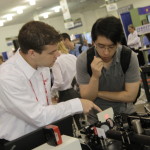By Lynn Savage
While I am sure that some people find that attending conferences can be a bit of a chore – something to get done as soon as possible before heading back to “real work” – that has never been true for me. And I don’t know you very well, but I’m guessing conferences aren’t a burden to you either, given that you’re here, reading about one that won’t arrive for months.
Of course, the one that we’re here to discuss is CLEO, one of the liveliest of all industry shows (and not just in the photonics industry). I’ll admit that I have a soft spot for CLEO; it was my first photonics conference ever (Baltimore, 2005, if you’re keeping score). The constant buzz of activity in the venue included a whirl of people and technologies that insisted on constant engagement. Academic researchers making last-minute adjustments to their presentations, post-docs
 Technologies being showcased at CLEO
Technologies being showcased at CLEO
seeking their assigned spot in the poster area, salespeople seeking places to converse with clients, marketing reps setting up trade show booths, CLEO management show-runners scrambling to make sure everything from registration to AV tech to the coatrooms were operating smoothly — everyone with their individual missions and goals, gathered together to make sparks fly. It was a heady mix for any first timer, but I was thrilled to be there and dive in with my own, journalistic, goals.
Although my current avocation is science journalism, it has come via a path that began when I first trained to become a mechanical drafter. Although this never became a career, I really enjoyed the design process and the meticulous way one must consider form and function when laying designs out on paper. One of my favorite things about being a student of the drafter’s craft, though, was perusing catalogs filled with mechanical devices, from simple screws and bolts to advanced tools and heavy machinery. These catalogs informed me of a larger world of invention and craftsmanship that I wanted to tap into.
So, as exciting as it is to hear about advances in basic science and perhaps-someday-feasible technologies coming out of academic, government, and commercial laboratories around world, seeing the best of the lot make their way into the “real” world of applications is, frankly, often thrilling. It’s like watching your favorite minor league ballplayer break into the big leagues, finally earning a chance to swing the bat against the Clayton Kershaws of the world.
To support the idea that exciting developments are happening on the path from lab to market, CLEO is looking for even more input in 2015 from optical engineers, the people who take promising research results and translate them into amazing products.
For CLEO: 2015, the CLEO team is looking for presentations that will delight and inspire future developments, making sure that there is a steady spotlight on the pipeline of innovation in the optics and photonics world. Specifically, the organization hopes to see submissions in the following areas:
Biomedical applications
-
Biomedical spectroscopy, microscopy, and imaging
-
Neurophotonics and brain activity monitoring
-
Optogenetics and optical control of cells
-
Light sources and devices for biomedical imaging
-
Clinical technologies and systems
Industrial applications
-
New laser sources for industrial use
-
Micro/nanoprocessing and manufacturing
-
Sensing and process control
-
Ultrafast lasers
Photonic instrumentation and techniques for metrology and industrial processes
-
Chemical sensing
-
Security applications
-
Process monitoring
-
Metrology
Lasers and photonic applications to energy and environment
-
New energy sources
-
Solar energy systems
-
Photonic instrumentation for energy and environment
CLEO is specifically seeking stories of evolving engineering efforts, including both maturing and already-implemented photonics technologies. Especially desired are introductions to and demonstrations of new products (without an accompanying overt sales pitch) or existing products with new capabilities; optical technologies at work in field situations, such as advanced sensors, metrology systems and the like; novel technologies useful to material fabricators and manufacturers; optical technologies useful in the design of system controls; and clinical applications of new or improved photonics-based sensors, cutting tools, or therapeutic approaches. The Society also is seeking exhibitions of optical engineering, especially hardware with new or significantly improved sensors, optical components and subsystems, optical designs for optical or electro-optical systems and subsystems; novel (or advancements to existing) optical system control/processing algorithms that enable new technical capabilities; new optics designs and measurement techniques; and advanced optics-based diagnostics systems.
Submitted papers are reviewed, with an eye toward “uniqueness, impact of the work, and how the work advanced the state of the art.”
So, if you have a choice bit of technology you’d like to show off to a wide-eyed group of people at next year’s meeting, heed the call for papers (http://www.cleoconference.org/home/submissions/) being requested by CLEO. The deadline is 16 December at 17.00 GMT.
Posted: 8 September 2014 by
Lynn Savage
| with 0 comments